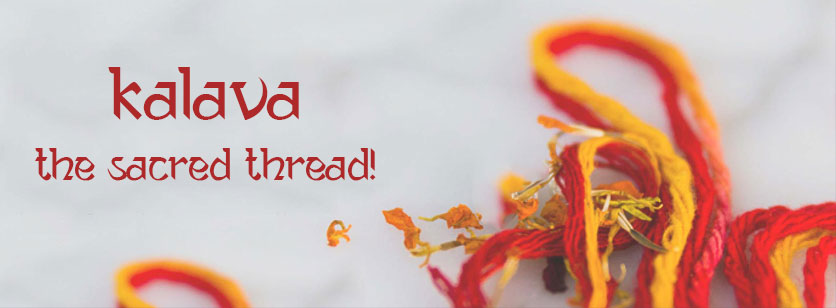
Kalava! Don’t we hear this word in almost every ritual of our Hindu Culture? Be it the Navratri poojan, Raksha Bandhan or any other important Hindu festival , we see a lot of wrists covered with this sacred saffron thread ‘Kalava’. The red-yellow dappled thread, also known as ‘Moli’, holds an important place and significance in every Hindu pooja. We often see Hindu priests tying this sanctified thread before commencing any religious ceremony on the hands of the devotees. Usually tied on the right wrist of men and unmarried and on the left wrist of the married women, ever wondered what makes this thread so religiously important?
Significance:
- The literal meaning of Sanskrit word ‘moli’ is ‘crown’ or something which is ‘above all’. This is the reason that Lord Shiva is regarded as ‘Chandramauli’ as he adorned the Moon on his matted hair.
- The story of the holy thread dates back to the time when Kunti tied the protective thread on the wrist of Abhimanyu before he went for the battle in the Mahabharata.
- It is believed that a person is blessed by Tridev (Brahma, Vishnu, and Mahesh) if they tie three rounds of this sacred thread on their wrists.
- It symbolizes the firm determination of the worshipper during the commemoration of Yagna, referred to as ‘Yajman’. Brahman invokes the deities and seeks divine benedictions’ for Yajmans and his family.
- It is the symbol of devotion that reminds the human being time to time about his vow and prevents him from getting diverted from his ambitions and paths.
- A devotee must keep his hand on his head while tying moli on his wrist as it is the symbol of vigilance and mindfulness that ‘Yes! We are aware while taking oath and we intend to perform our duty earnestly”.
- Just like Raksha Bhandan, it works as the ‘Raksha sutra’ (protective thread) for the devotee against all types of negativities as well as diseases.
- It encompasses the humans with certain obligations that are framed by the God and helps a person in connecting his human soul with the Almighty.
According to Bhagavad Gita, no one on Earth is free from three Gunas of nature: Rajas (passion), Tamas (darkness or destruction) and Satva (purity). These gunas deeply affect our state of mind, our moods, nature and our behavior. For example: a mother who feeds her baby is said to be satvik; She plays and adores his baby as Rajas and gives her naps generously as Tamas. The thread on the wrist helps one control mood swings that one experiences time and again in their daily life and gets them into the Satvik state, which is pure and placid. So, the next time you see somebody tying moli on wrists, take a step forward and present them your wrist too!
 +91 9990176000
+91 9990176000 +91 9999097600
+91 9999097600
 CALENDAR 2024
CALENDAR 2024










